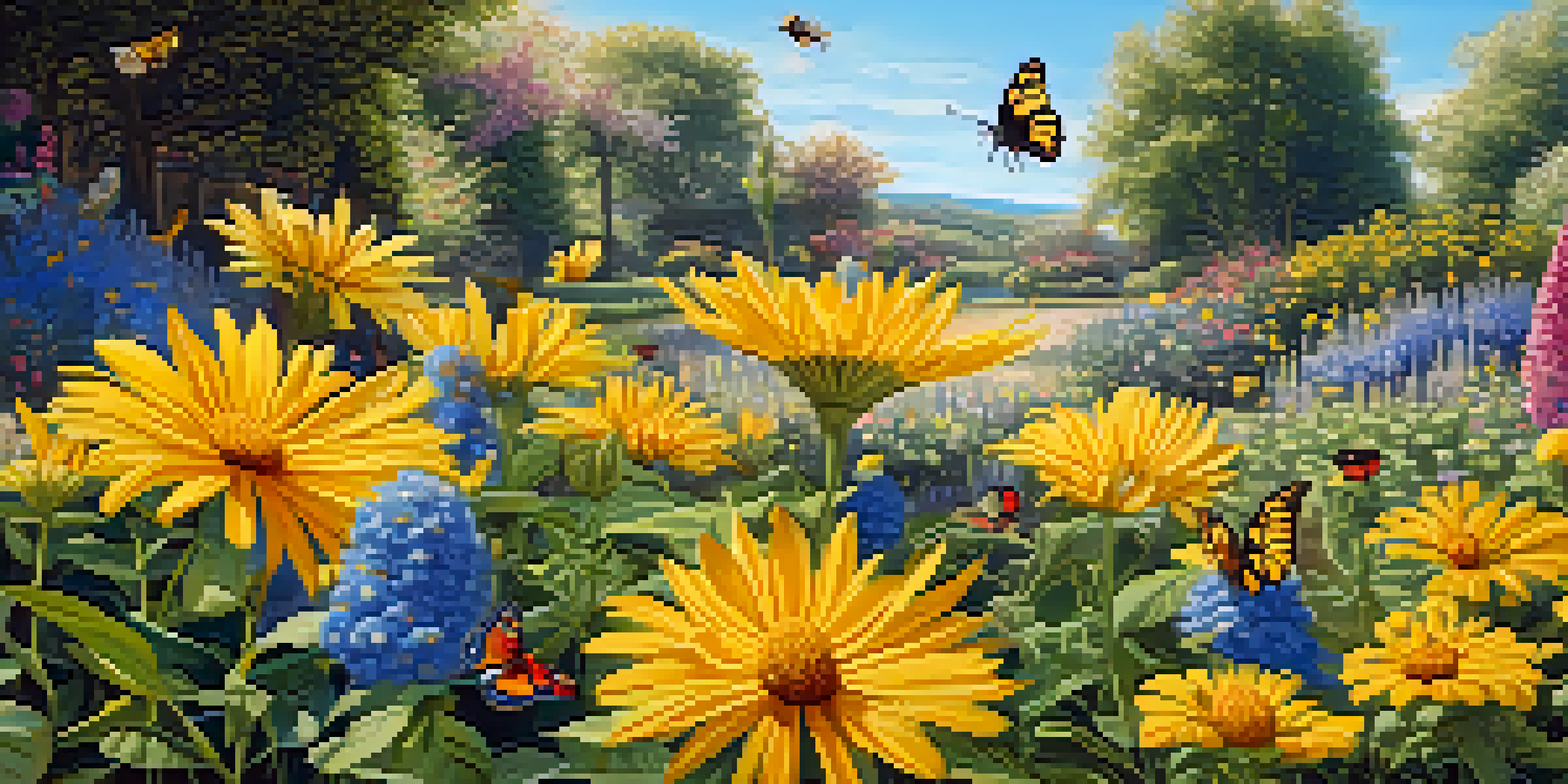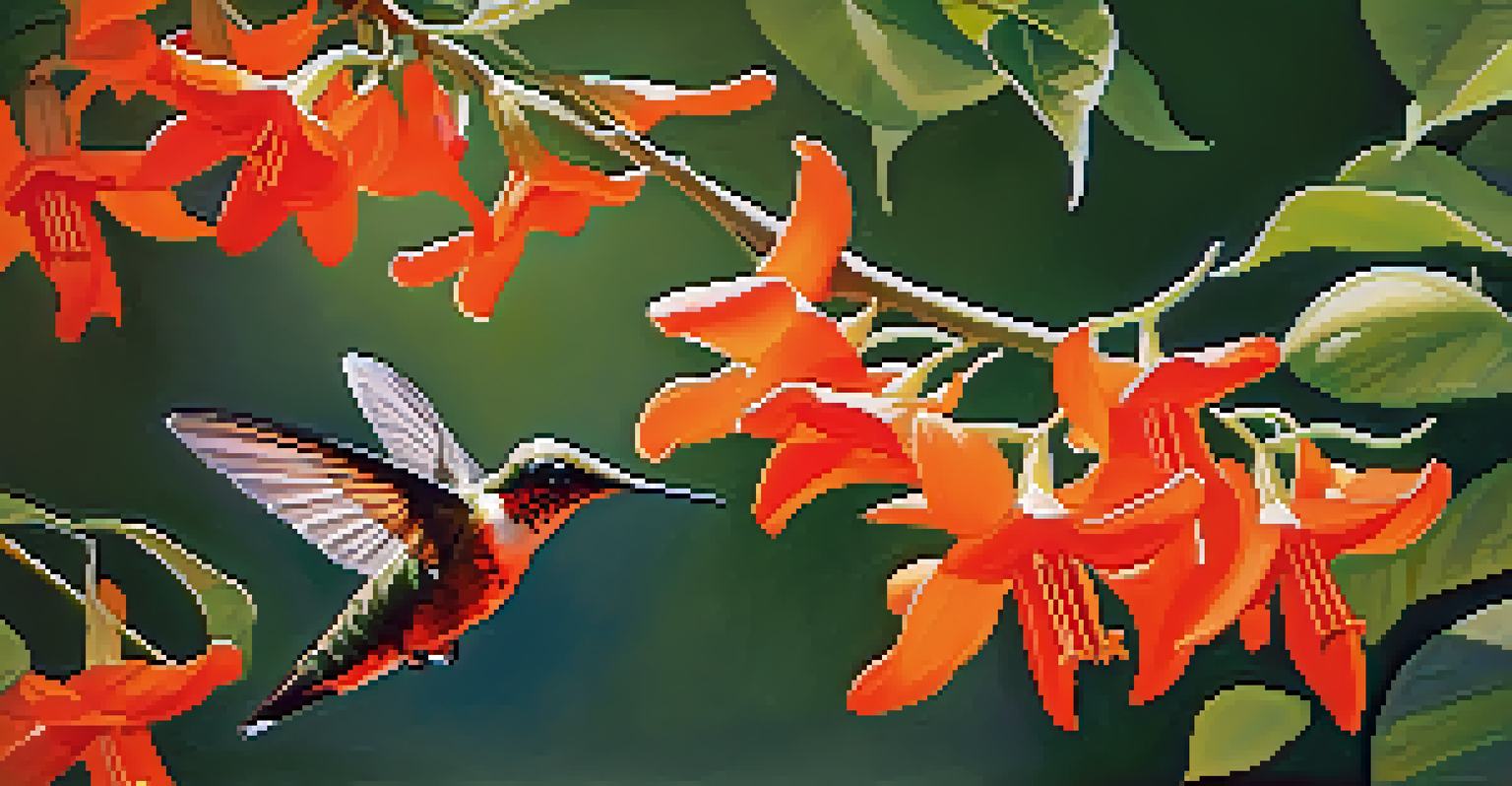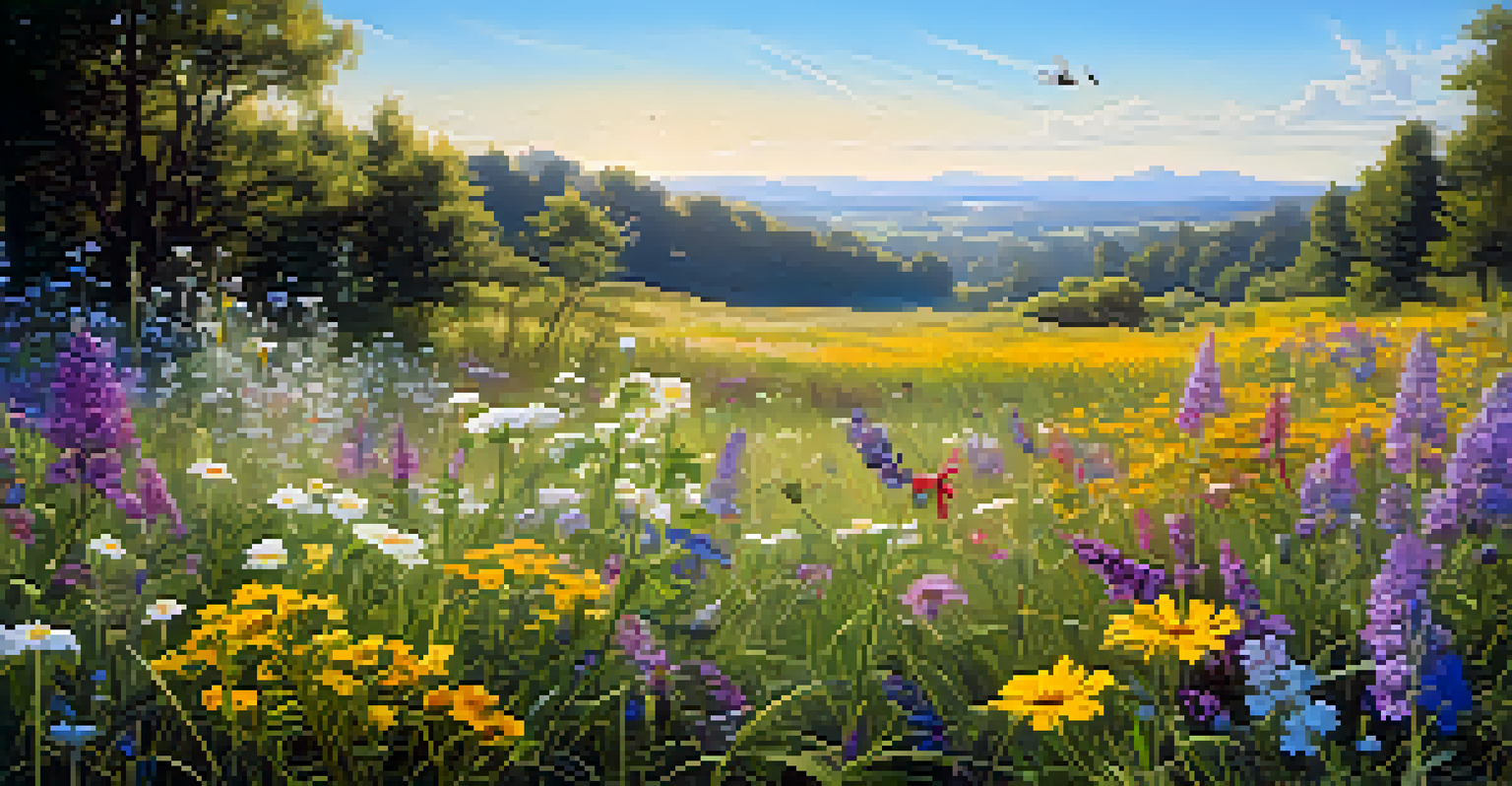The Relationship Between Pollinators and Plant Adaptations

Understanding Pollinators: The Unsung Heroes of Nature
Pollinators, such as bees, butterflies, and birds, play a crucial role in our ecosystems. They help in the reproduction of flowering plants by transferring pollen from one bloom to another. This natural process not only supports plant diversity but also ensures food production for both wildlife and humans. Without these dedicated helpers, many plants would struggle to reproduce, leading to decreased biodiversity.
If we kill off the wildness in our animals and our plants, we will be killing off a part of ourselves.
Imagine walking through a vibrant garden alive with color and fragrance. Each flower you see owes its existence, in part, to pollinators that have facilitated its growth through pollination. These creatures are often overlooked, yet their influence is paramount for plant evolution and adaptation. Every time a pollinator visits a flower, it initiates a chain reaction that supports the entire food web.
The relationship between pollinators and plants is like a dance, each partner adapting to enhance the performance. As pollinators evolve, so do the plants they interact with, creating a beautiful synergy that has been cultivated over millions of years. This intricate partnership is fundamental to maintaining ecological balance and ensuring the survival of diverse plant species.
How Plant Adaptations Attract Pollinators
Plants have developed a variety of traits to attract pollinators, from vibrant colors to enticing scents. Brightly colored flowers often signal to pollinators that nectar is nearby, making them irresistible. Similarly, plants that emit strong fragrances can draw in pollinators from great distances, ensuring their survival and reproduction. These adaptations are not merely aesthetic; they are essential for the plant's reproductive success.

Consider the deep, tubular flowers of trumpet vines, which are perfectly shaped for hummingbirds. This adaptation not only attracts these birds but also ensures that they can access the nectar, allowing for effective pollen transfer. Such specific adaptations illustrate how plants have tailored their features to meet the needs of particular pollinators, highlighting the importance of mutualism in nature.
Pollinators Are Essential for Ecosystems
Pollinators like bees and butterflies are crucial for plant reproduction, supporting biodiversity and food production.
Moreover, some plants have evolved to have landing pads or open structures that provide a convenient resting place for pollinators. These adaptations enhance the chances of successful pollination, as pollinators can easily access the reproductive parts of the flower. This strategic design showcases the remarkable ways plants have evolved alongside their pollinator partners.
The Role of Color and Fragrance in Pollinator Attraction
When it comes to attracting pollinators, color and fragrance are key players. Different pollinators are drawn to specific colors; for instance, bees are particularly attracted to blue and yellow flowers. This color preference has driven plants to evolve hues that stand out in their environment, ensuring they catch the attention of these critical helpers. The vibrant palette of nature is not just for our enjoyment; it serves a vital purpose.
The future will be shaped by the decisions we make today, and it is our responsibility to protect the delicate balance of nature.
Fragrance is another powerful tool in a plant's arsenal. Sweet scents can lure in pollinators from afar, while some flowers emit more subtle, musky aromas to attract specific species. For example, night-blooming flowers often rely on nocturnal pollinators like moths, emitting strong fragrances to guide them in the dark. These adaptations illustrate the sophisticated strategies plants employ to enhance their reproductive success.
In many ways, the relationship between color, scent, and pollinator preference is a beautiful example of evolution in action. As pollinators adapt to recognize these signals, plants simultaneously refine their features to match. This ongoing interplay drives the diversity we see in flowering plants and highlights the importance of maintaining healthy ecosystems.
The Impact of Habitat Loss on Pollinator Populations
Unfortunately, habitat loss presents a significant challenge to both pollinators and the plants that depend on them. Urbanization, deforestation, and agricultural expansion have dramatically reduced the natural environments where pollinators thrive. As their habitats dwindle, many pollinator species face declining populations, which can lead to a cascading effect on plant reproductive success. This scenario not only threatens biodiversity but also food security.
Imagine a once-bustling meadow filled with wildflowers, now replaced by concrete and asphalt. The loss of such habitats means fewer food sources for pollinators, making it harder for them to survive and reproduce. This decline can create an imbalance in ecosystems, as plants that rely on these pollinators may fail to thrive, leading to further loss of plant diversity.
Habitat Loss Threatens Pollinators
Urbanization and deforestation significantly reduce natural habitats, leading to declining pollinator populations and threatening plant diversity.
To combat these challenges, conservation efforts are essential. Creating pollinator-friendly spaces, such as gardens with native plants, can help support these vital creatures. By understanding the impact of habitat loss, we can take steps to protect pollinators and, in turn, safeguard the plants that rely on them.
Climate Change: A Growing Threat to Pollinators
Climate change presents a significant challenge to the delicate balance between pollinators and plants. As temperatures rise and weather patterns shift, many pollinators find it difficult to adapt to new conditions. For example, some species may emerge from hibernation too early, missing the peak flowering time of their food sources. This mismatch can disrupt the entire ecosystem, leading to reduced pollination success.
Additionally, changing climates can alter the distribution of both pollinators and plants. As certain species migrate to find suitable habitats, they may no longer overlap with the plants they once pollinated. This shift can have dire consequences for both the plants and the animals that depend on them for food. Understanding these dynamics is crucial for conservation efforts aimed at preserving biodiversity.
To mitigate the effects of climate change on pollinators, we must embrace sustainable practices that protect their habitats. Planting native species, reducing pesticide use, and creating green spaces can help ensure that pollinators have the resources they need. By taking action now, we can help secure a stable future for both pollinators and the plants that rely on their services.
Conservation Efforts: Protecting Pollinators and Plants
Conservation initiatives play a vital role in protecting our planet's pollinators and the plants that depend on them. Organizations and communities are increasingly recognizing the importance of preserving natural habitats and creating pollinator-friendly environments. These efforts can range from planting native gardens to advocating for sustainable agricultural practices that support both pollinators and plant health.
One successful example of conservation in action is the establishment of pollinator corridors—areas of habitat that connect fragmented landscapes. These corridors provide safe passage for pollinators, allowing them to move freely between food sources and nesting sites. By creating networks of suitable habitats, we can help bolster pollinator populations and enhance plant reproduction, fostering a healthier ecosystem.
Climate Change Impacts Pollinators
Shifting climates disrupt the synchronization between pollinators and plants, jeopardizing effective pollination and ecosystem balance.
Moreover, education and awareness campaigns are crucial in promoting the significance of pollinators. By encouraging individuals to take action in their own backyards, we can collectively make a difference. Simple steps, such as reducing pesticide use and planting diverse flora, can significantly impact pollinator health and plant survival.
The Future of Pollinators and Plant Adaptations
The future of pollinators and plant adaptations hinges on our collective actions today. As we confront the challenges posed by habitat loss and climate change, it's essential to prioritize conservation efforts. By investing in research and sustainable practices, we can better understand the dynamics between pollinators and plants, ensuring their survival for generations to come.
Innovative approaches, such as urban gardening and incorporating native plants into landscaping, can help create conducive environments for pollinators. These initiatives not only support local biodiversity but also foster a deeper connection between communities and nature. With increased awareness, we can inspire others to join the movement and advocate for the protection of these vital relationships.

Ultimately, the relationship between pollinators and plants is a testament to the intricate web of life on Earth. By nurturing this connection, we can help preserve the beauty and diversity of our natural world, ensuring that both pollinators and plants continue to thrive in harmony.